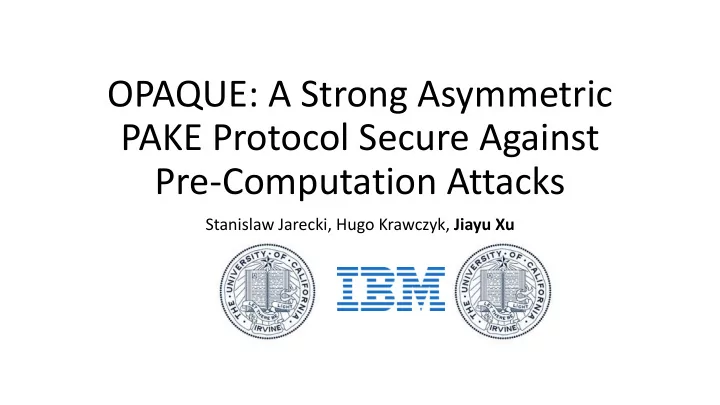

OPAQUE: A Strong Asymmetric PAKE Protocol Secure Against Pre-Computation Attacks Stanislaw Jarecki, Hugo Krawczyk, Jiayu Xu
Motivation: Password Authentication • Passwords are the prevalent tool for authentication • Passwords are vulnerable to various attacks • Human memorable ⇒ low-entropy • Reusing the same / highly correlated password
Password Protocols in Crypto Literature • (Symmetric) Password- Authenticated Key Exchange (PAKE) [BMP’00, BPR’00] pw pw SK SK • Password-only: no Public Key Infrastructure (PKI)!
PAKE in the Client- Server Setting… • Server compromised ⇒ password leaked straight away! pw pw SK SK
Asymmetric / Augmented PAKE (aPAKE) [BM’93, BMP’00, GMR’06] • Server stores a mapping of the password (“password file”) • Server compromised ⇒ only unavoidable offline dictionary attack allowed ⇒ O(|D|) time to learn the password pw H(pw) pw 1 H(pw 1 ) pw 2 H(pw 2 ) … … SK SK
Wait, What if the Adversary… • …computes the hash table prior to compromising the server… • …and upon compromising the server, compares the password file against the pre-computed hash values? • “ pre-computation attack ” pw H(pw) pw 1 H(pw 1 ) pw 2 H(pw 2 ) … … SK SK
Pre-Computation Attack • O(log|D|) time to learn the password after server compromise! • How to force the adversary to spend O(|D|) time on offline dictionary attack after server compromise? • Store (s,H(pw,s)) where s is a private random salt • Strong aPAKE (SaPAKE): secure against pre-computation attacks
aPAKE: State-of-Art • Formal definition • Game- based [BMP’00, BP’13] • Universally-composable (UC) [GMR’06] • Very few proposals proven secure • All of them allow for pre-computation attack! • No salt in password hash / salt is sent in the clear • Does not quite meet the motivation behind aPAKE definition…
In Practice: Password-over-TLS pw (s,H(pw,s)) TLS(pw) pw check against password file
Password-over-TLS v. aPAKE Password-over-TLS aPAKE Requires PKI Password-only Server sees password Server never sees upon TLS decryption password Requires full offline Allows for pre- dictionary attack upon computation attack server compromise • Strong aPAKE: combines the good parts of both!
Our Contributions • (1) The first definition of Strong aPAKE • …and it is in the UC setting • Preferable than game-based definitions (non-uniform distribution of password, password correlation, easier to argue, etc.) • (2) Two highly efficient realizations of Strong aPAKE (the latter named OPAQUE) in the Random Oracle Model (ROM) • …and proven secure in the UC setting
• The UC aPAKE functionality in [GMR’06] (full text) • …Allows for pre -computation attack (grey text) • Our UC SaPAKE functionality does not (grey text omitted)
Our Tool: Oblivious PRF (OPRF) [NR’97, FIPR’05, JKK’14] x k ⊥ y=PRF k (x) • Very efficient instantiation: DH-OPRF (in the UC setting [JKKX’16 ])
Construction #1: OPRF + aPAKE → SaPAKE (k,H(rw)) pw k OPRF rw=PRF k (pw) rw H(rw) aPAKE SK SK • rw is random to the adversary ⇒ cannot launch pre-computation attack on rw (thanks to k)
Construction #2: OPRF + AKE → SaPAKE (k,c,priv S ,pub S ,pub U ) pw k OPRF rw=PRF k (pw) c = AuthEnc rw (priv U ,pub U ,pub S ) priv U ,pub S ,pub U priv S ,pub S ,pub U AKE SK SK * AKE has the Key Compromise Impersonation (KCI) property
OPAQUE • Practical instantiation of “OPRF+AKE” construction • Very efficient (based on DH-OPRF) • AKE can be instantiated using various protocols • Variants studied previously [FK’00, Boyen’09, JKKX’16] • First analysis as aPAKE and SaPAKE
OPAQUE with HMQV [K’05] HMQV:
OPAQUE Performance (with HMQV) • Single round (one message from client, one message from server) • OPRF and AKE can be done simultaneously • Computational cost: comparable to the most efficient existing aPAKE Per user Per server SPAKE2+ [AP’05] ~3.5 exps ~3.5 exps No rigorous proof VTBPEKE [GW’17] 4 exps 4 exps Not in UC [JR’16] 4 exps + 3 4 exps + 3 Works in pairing pairings pairings groups only OPAQUE ~4.17 exps ~3.17 exps
OPAQUE Features • Efficient and provable secure • Proof is modular: works for any UC OPRF and UC AKE-KCI • Combination of good properties of aPAKE and password-over-TLS • Password only (non-PKI) • Server never sees password • Eliminates pre-computation attack (the only such protocol in non-PKI setting!)
TLS Integration • TLS Integration • Ciphertext c (sent from server to user) can contain user’s other secrets, e.g. user’s TLS signature key • Key exchange of OPAQUE can reuse that of TLS (no need to run two separate key exchanges): importance of generic composition • Protects user ID • TLS protected by OPAQUE v. password protected by TLS
OPAQUE Extensions • Explicit authentication • Add one message (user sends f K (1), server sends f k (2) – server’s message can be “piggybacked”) • Server-side threshold implementation • Use Threshold OPRF [JKKX’17] • Adversary needs to compromise a specific number (“threshold”) of servers to launch offline dictionary attack
OPAQUE: A Strong Asymmetric PAKE Protocol Secure Against Pre-Computation Attacks THANK YOU! Stanislaw Jarecki, Hugo Krawczyk, Jiayu Xu https://eprint.iacr.org/2018/163
Recommend
More recommend